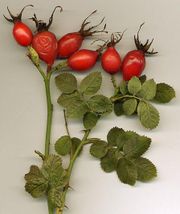Rosa Canina (Dog Rose)

The aggregate fruit of the rose is a berry-like structure called a rose hip. Rose species that produce open-faced flowers are attractive to pollinating bees and other insects, thus more apt to produce hips. Many of the domestic cultivars are so tightly petalled that they do not provide access for pollination. The hips of most species are red, but a few (e.g. Rosa pimpinellifolia) have dark purple to black hips. Each hip comprises an outer fleshy layer, the hypanthium, which contains 5–160 "seeds" (technically dry single-seeded fruits called achenes) embedded in a matrix of fine, but stiff, hairs. Rose hips of some species, especially the Dog Rose (Rosa canina) and Rugosa Rose (Rosa rugosa), are very rich in vitamin C, among the richest sources of any plant. The hips are eaten by fruit-eating birds such as thrushes and waxwings, which then disperse the seeds in their droppings. Some birds, particularly finches, also eat the seeds.
Most roses have thorns or prickles. The thorns are typically sickle-shaped hooks, which aid the rose in hanging onto other vegetation when growing over it. Some species such as Rosa rugosa and R. pimpinellifolia instead have densely packed straight spines, probably an adaptation to reduce browsing by animals, but also possibly an adaptation to trap wind-blown sand and so reduce erosion and protect their roots (both of these two species grow naturally on coastal sand dunes). Despite the presence of the thorns, roses are frequently browsed by deer. A few species of roses only have vestigial thorns that have no points.
Roses are subject to several diseases. The most serious is rose rust (Phragmidium mucronatum), a species of rust fungus, which can defoliate the plant. More common, though less debilitating, are rose black spot [1], caused by the fungus Diplocarpon rosae, which makes circular black spots on the leaves in summer, and powdery mildew, caused by Sphaerotheca pannosa. Roses are also used as food plants by the larvae of some Lepidoptera species; see list of Lepidoptera which feed on Roses.
These fungal diseases are best solved by a preventative spray program rather than by trying to cure an infection after it is visible.

0 Comments:
Post a Comment
<< Home